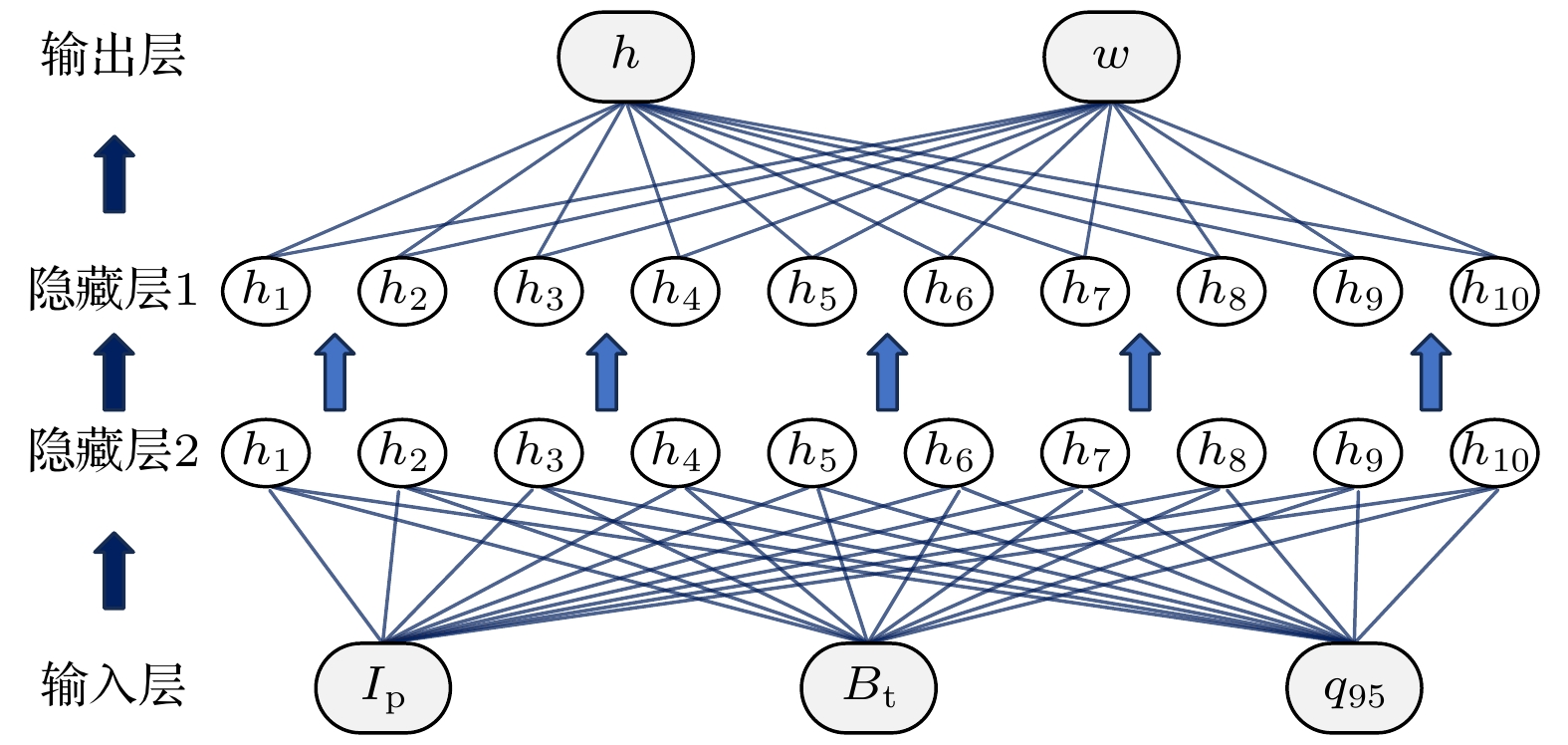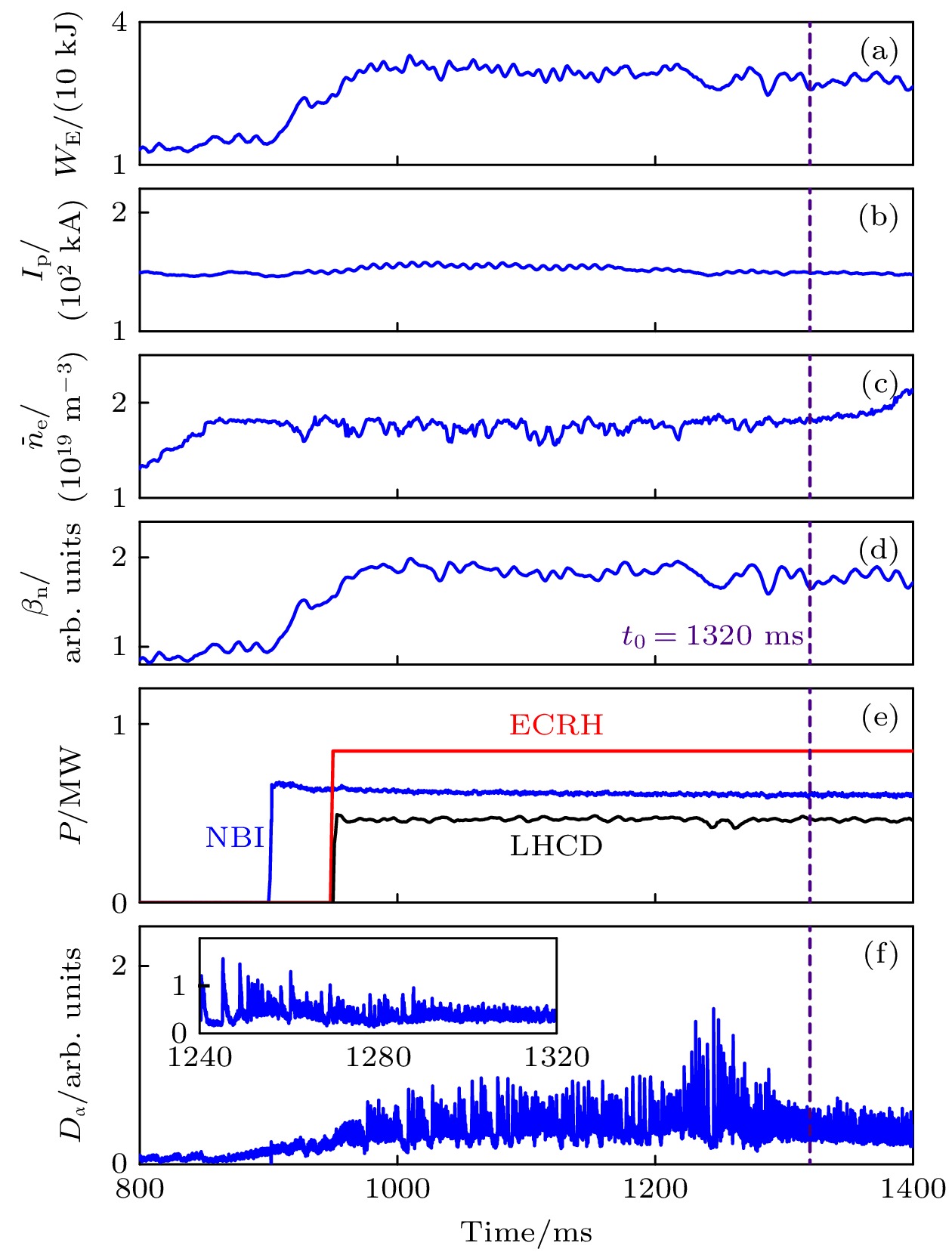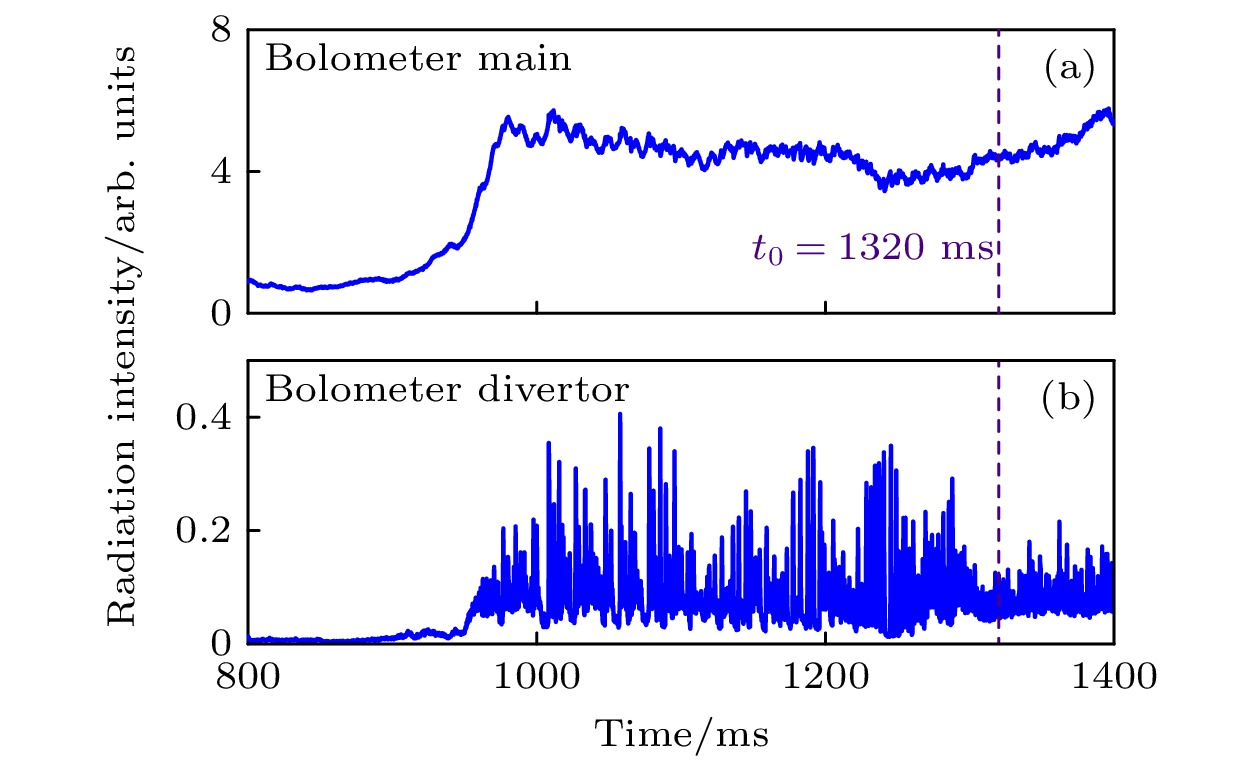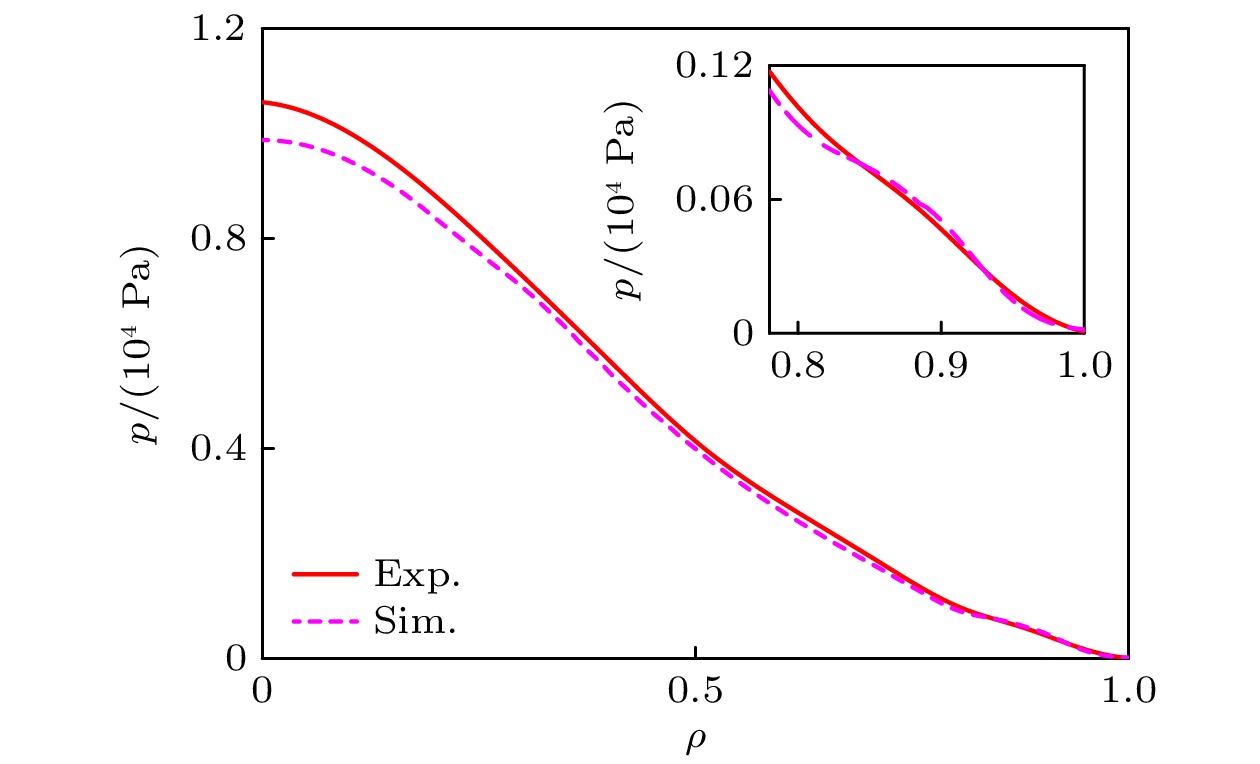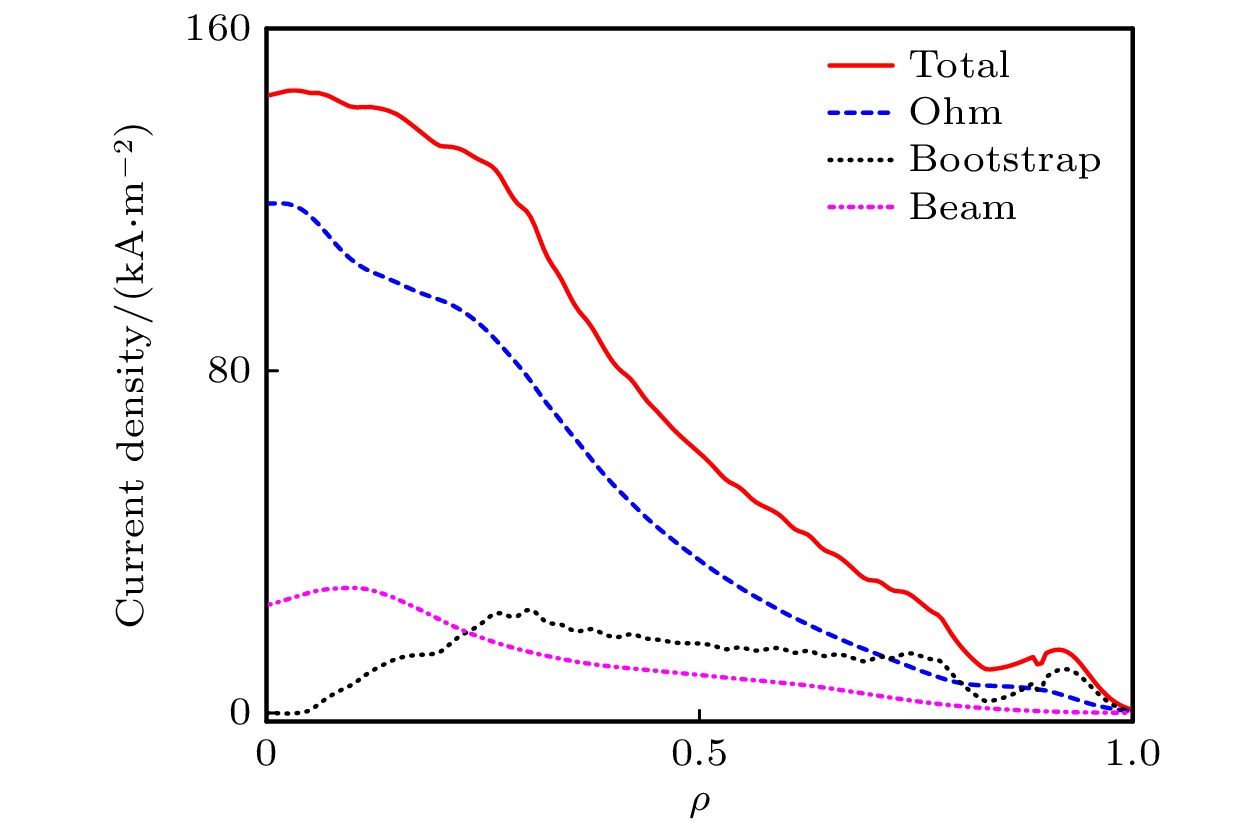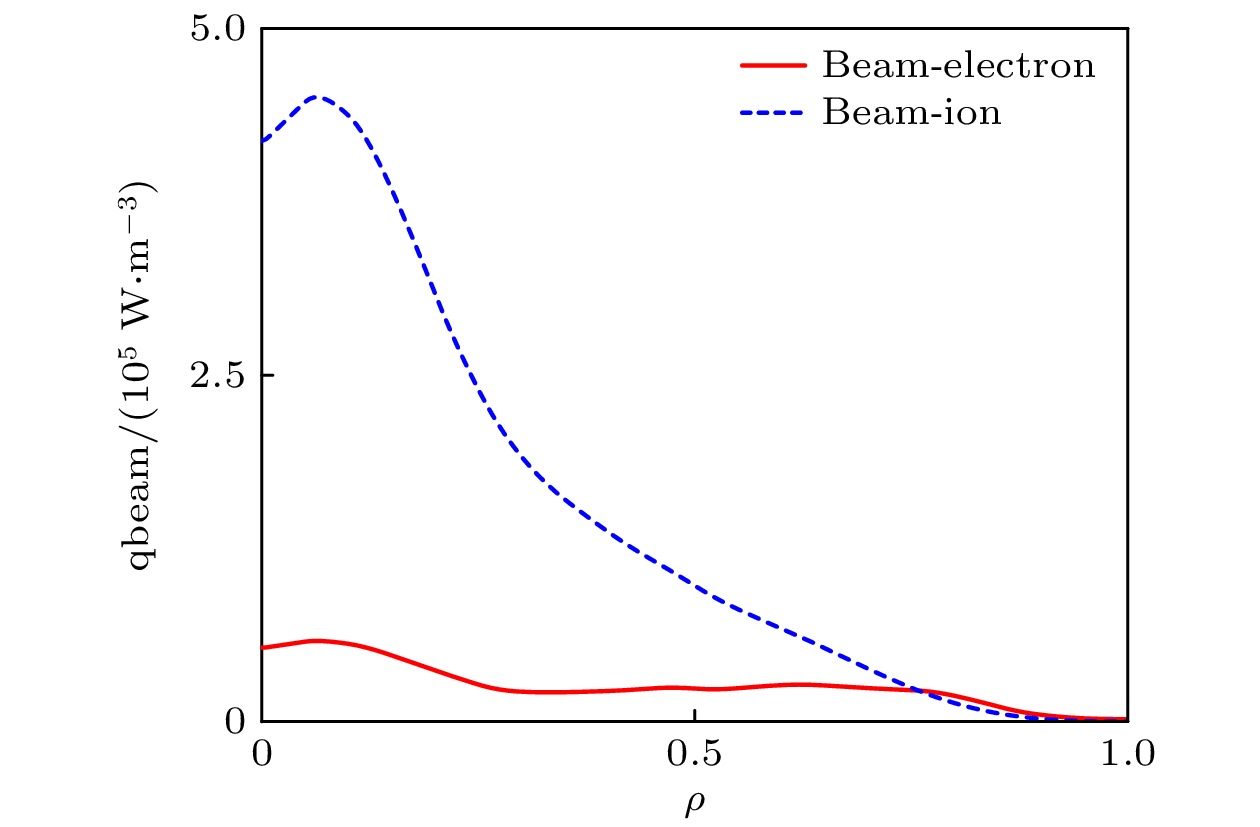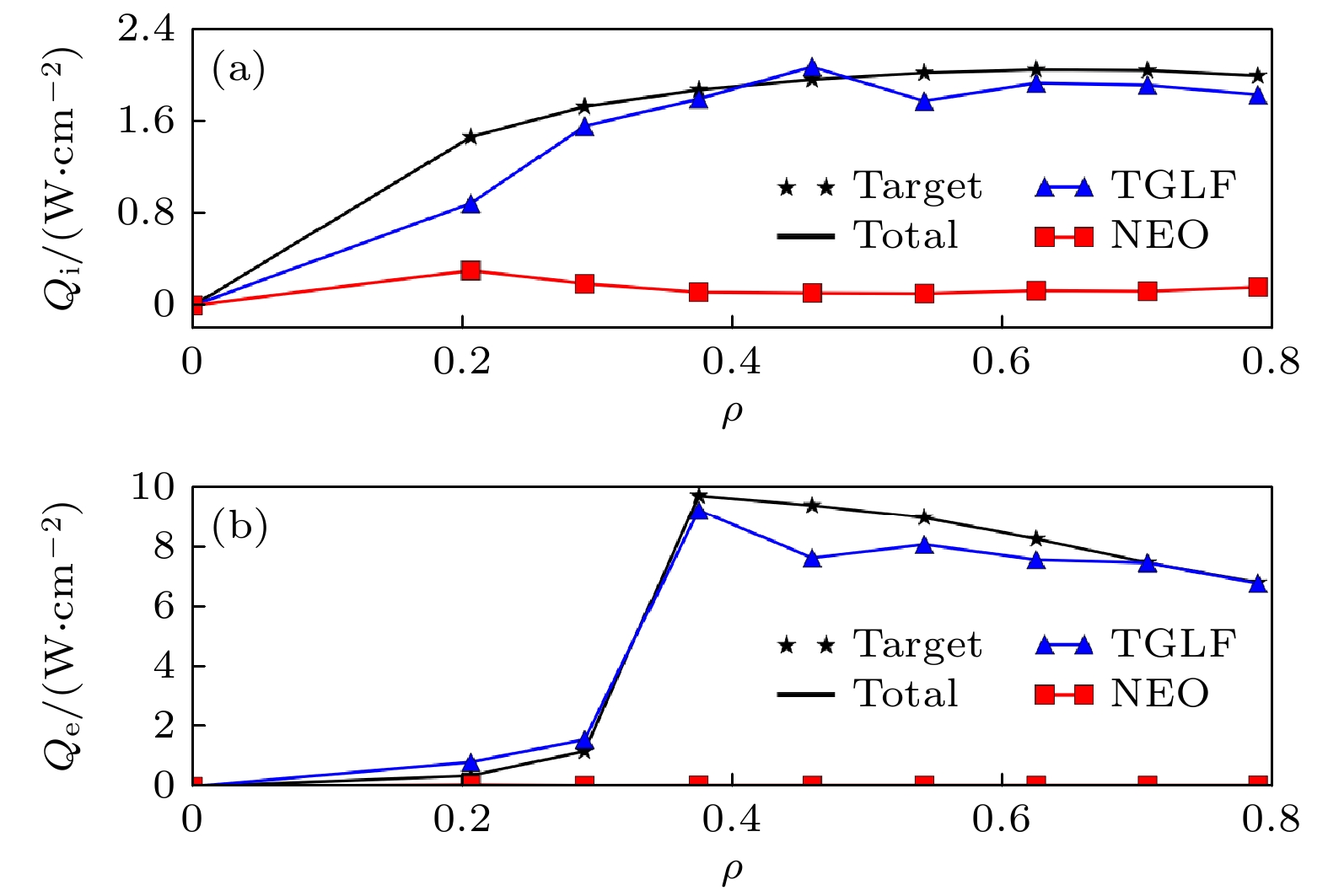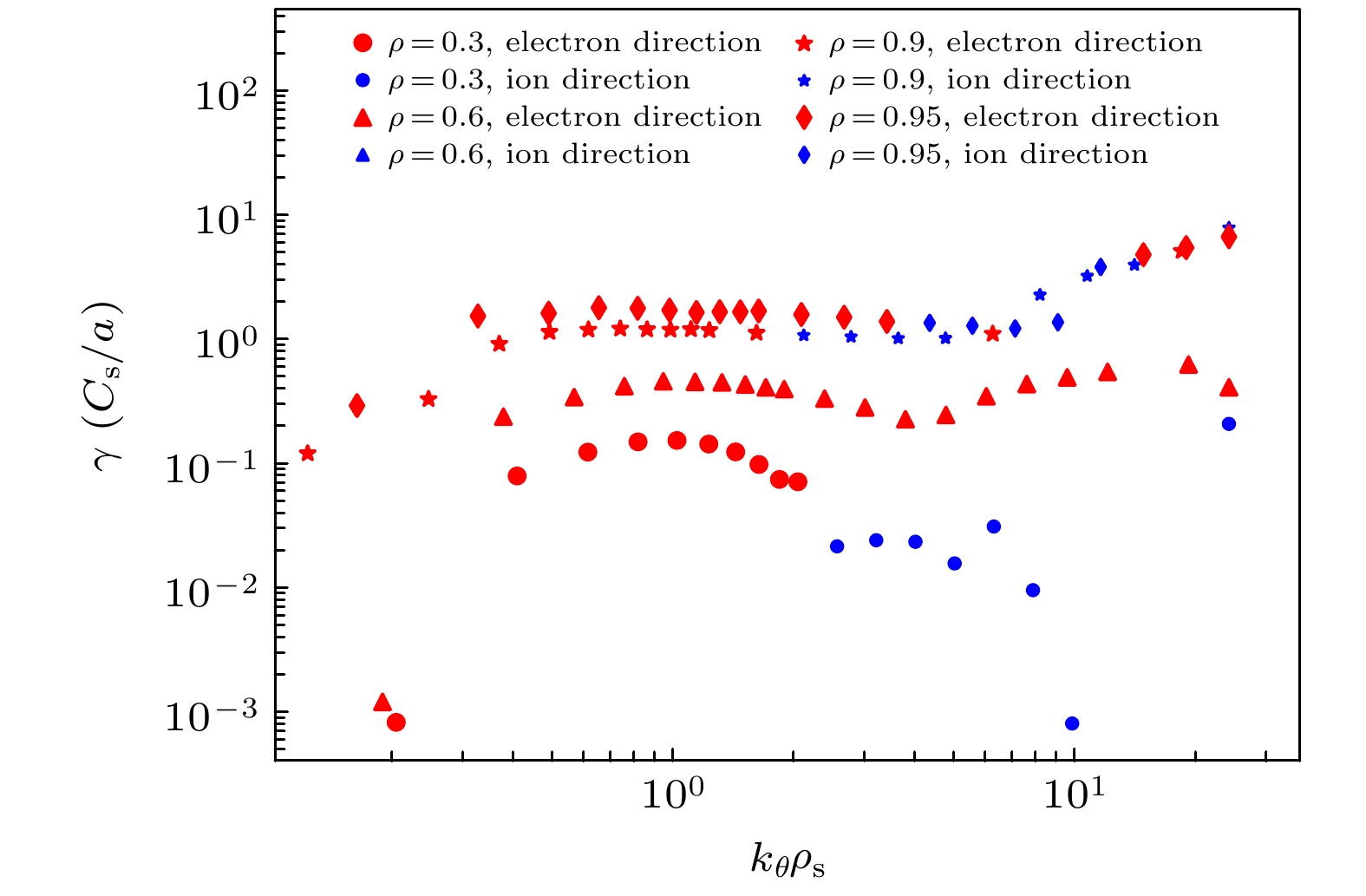-
托卡马克高约束H模条件下偏滤器脱靶和热流控制是当前磁约束核聚变研究中的关键物理问题. 脱靶对H模边界输运物理尤其是对芯部约束兼容性的影响是研究偏滤器脱靶物理的关键问题. 本文获得了HL-2A装置H模等离子体偏滤器脱靶与芯部约束兼容的实验结果, 采用OMFIT集成模拟平台, 新发展了偏滤器靶板区的神经网络快速集成模拟方法, 率先采用该快速集成模拟方法开展HL-2A第39007炮高约束模式下, 边界偏滤器脱靶与芯部约束兼容性的集成模拟研究, 经验证集成模拟结果与实验结果相吻合. 通过进一步分析发现: HL-2A装置H模脱靶情况下, 在芯部$ 0.1 < \rho \leqslant {\mathrm{ }}0.5 $的区域内高极向波数($ {k}_{\theta }{\rho }_{{\mathrm{s}}} $>1)模式下的湍性输运以离子温度梯度(ITG)模主导, 在芯部$ 0.5 < \rho \leqslant {\mathrm{ }}0.7 $的区域内的湍性输运以电子湍流主导; 而边界则是在归一化极向波数$ {k}_{\theta }{\rho }_{{\mathrm{s}}} < 2 $的情况下由电子湍流主导, $ {k}_{\theta }{\rho }_{{\mathrm{s}}} > 2 $的情况下则以ITG为主, 并伴有少量的电子湍流. 本文研究结果为托卡马克装置芯边耦合物理研究提供了一定的集成模拟与实验验证基础.The divertor detachment and heat flux control under high-confinement H-mode conditions in tokamaks represent critical physical challenges in current magnetic confinement fusion research. Understanding the influence of detachment on H-mode boundary transport physics, particularly its compatibility with core confinement, is central to resolving divertor detachment physics. In this study, experimental results on divertor detachment and core confinement compatibility in H-mode plasma from the HL-2A tokamak are presented. On the objective magnetohydrodynamic framework for integrated tasks (OMFIT) integrated modeling platform, a novel neural network-based fast integrated modeling method for the divertor target region is developed by integrating a new edge neural network module (Kun-Lun Neural Networks, KLNN) to enhance divertor, scrape-off-layer and edge pedestal fast prediction capability. For the first time, this method is used to conduct integrated simulations of divertor detachment and core confinement compatibility in HL-2A discharge #39007 under high-confinement mode. The simulation results are validated with experimental measurements, demonstrating that they are well consistent. Further analysis reveals that in HL-2A H-mode detachment scenarios, turbulent transport in the core region ($ 0.1 < \rho \leqslant 0.5 $) with high poloidal wave numbers $ ({k}_{\theta }{\rho }_{{\mathrm{s}}} > 1 $) is dominated by ion temperature gradient (ITG) mode, while electron-driven turbulence prevails in the region $ (0.5 < \rho \leqslant 0.7) $. In the boundary region, electron turbulence dominates at low normalized poloidal wave numbers ($ {k}_{\theta }{\rho }_{{\mathrm{s}}} < 2 $), whereas ITG modes become predominant at higher wave numbers ($ {k}_{\theta }{\rho }_{{\mathrm{s}}} > 2 $), accompanied by minor electron turbulence contributions. The research results of this work provide a certain foundation for integrated simulation and experimental verification in the study of core-edge coupling physics in tokamak devices and some insights for understanding detachment-compatible H-mode scenarios in the next-step fusion devices.
-
Keywords:
- tokamak /
- detachment /
- H mode /
- integrated simulation
[1] 孙有文, 仇志勇, 万宝年 2024 73 175202
 Google Scholar
Google Scholar
Sun Y W, Qiu Z Y, Wan B N 2024 Acta Phys. Sin. 73 175202
 Google Scholar
Google Scholar
[2] Ida K, Fujita T 2018 Plasma Phys. Control. Fusion 60 033001
 Google Scholar
Google Scholar
[3] Leonard A W 2018 Plasma Phys. Control. Fusion 60 044001
 Google Scholar
Google Scholar
[4] Wang L, Wang L, Wang H Q, Eldon D, Yuan Q P, Ding S, Li K D, Garofalo A M, Gong X Z, Xu G S, Guo H Y, Wu K, Meng L Y, Xu J C, Liu J B, Chen M W, Zhang B, Duan Y M, Ding F, Yang Z S, Qian J P, Huang J, Ren Q L, Leonard A W, Fenstermacher M, Lasnier C, Watkins J G, Shafer M W, Barr J, Weisberg D, McClenaghan J, Hanson J, Hyatt A, Osborne T, Thomas D, Humphreys D, Buttery R J, Luo G N, Xiao B J, Wan B N, Li J G 2021 Nat. Commun. 12 1365
 Google Scholar
Google Scholar
[5] 孟令义 2022 博士学位论文 (合肥: 中国科学技术大学)
Meng L Y 2022 Ph. D. Dissertation (Hefei: University of Science and Technology of China
[6] Wu T, Nie L, Yu Y, Gao J M, Li J Y, Ma H C, Wen J, Ke R, Wu N, Huang Z H, Liu L, Zheng D L, Yi K Y, Gao X Y, Wang W C, Cheng J, Yan L W, Cai L Z, Wang Z H, Xu M, 2023 Plasma Sci. Technol. 25 015102
 Google Scholar
Google Scholar
[7] 秦晨晨, 牟茂淋, 陈少永 2023 72 045203
 Google Scholar
Google Scholar
Qin C C, Mou M L, Chen S Y 2023 Acta Phys. Sin. 72 045203
 Google Scholar
Google Scholar
[8] 龙婷, 柯锐, 吴婷, 高金明, 才来中, 王占辉, 许敏 2024 73 088901
 Google Scholar
Google Scholar
Long T, Ke R, Wu T, Gao J M, Cai L Z, Wang Z H, Xu M 2024 Acta Phys. Sin. 73 088901
 Google Scholar
Google Scholar
[9] Luce T C, Challis C D, Ide S, Joffrin E, Kamada Y, Politzer P A, Schweinzer J, Sips A C C, Stober J, Giruzzi G, Kessel C E, Murakami M, Na Y S, Park J M, Polevoi A R, Budny R V, Citrin J, Garcia J, Hayashi N, Hobirk J, Hudson B F, Imbeaux F, Isayama A, McDonald D C, Nakano T, Oyama N, Parail V V, Petrie T W, Petty C C, Suzuki T, Wade M R, the ITPA Integrated Operation Scenario Topical Group Members, the ASDEX-Upgrade Team, the DIII-D Team, JET EFDA Contributors, the JT-60U Team 2014 Nucl. Fusion 54 013015
 Google Scholar
Google Scholar
[10] Imbeaux F, Pinches S D, Lister J B, Buravand Y, Casper T, Duval B, Guillerminet B, Hosokawa M, Houlberg W, Huynh P, Kim S H, Manduchi G, Owsiak M, Palak B, Plociennik M, Rouault G, Sauter O, Strand P 2015 Nucl. Fusion 55 123006
 Google Scholar
Google Scholar
[11] Meneghini O, Smith S P, Lao L L, Izacard O, Ren Q, Park J M, Candy J, Wang Z, Luna C J, Izzo V A, Grierson B A, Snyder P B, Holland C, Penna J, Lu G, Raum P, McCubbin A, Orlov D M, Belli E A, Ferraro N M, Prater R, Osborne T H, Turnbull A D, Staebler G M, the ATOM Team 2015 Nucl. Fusion 55 083008
 Google Scholar
Google Scholar
[12] Zheng J X, Song Y T, Huang X Y, Lu K, Xi W B, Ding K Z, Ye B, Niu E W 2013 Plasma Sci. Technol. 15 152
 Google Scholar
Google Scholar
[13] 罗一鸣, 王占辉, 陈佳乐, 吴雪科, 付彩龙, 何小雪, 刘亮, 杨曾辰, 李永高, 高金明, 杜华荣, 昆仑集成模拟设计组 2022 71 075201
 Google Scholar
Google Scholar
Luo Y M, Wang Z H, Chen J L, Wu X K, Fu C L, He X X, Liu L, Yang Z C, Li Y G, Gao J M, Du H R, Kunlun Integrated Simulation and Design Group 2022 Acta Phys. Sin. 71 075201
 Google Scholar
Google Scholar
[14] 罗一鸣 2022 硕士学位论文 (成都: 核工业西南物理研究院)
Luo Y M, 2022 M S Thesis (Chendu: Southwestern Institute of Physics
[15] John H S, Taylor T S, Lin-Liu Y R, Turnbull A D 1994 Plasma Phys. Controlled Fusion 3 603
 Google Scholar
Google Scholar
[16] Lao L L, John H S, Stambaugh R D, Kellman A G, Pfeiffer W, 1985 Nucl. Fusion 25 1421
 Google Scholar
Google Scholar
[17] Pan C, Staebler G M, Lao L L, Garofalo A M, Gong X, Ren Q, Smith S P 2017 Nucl. Fusion 57 036018
 Google Scholar
Google Scholar
[18] Pankin A, McCune D, Andre R, Bateman G, Kritz A 2004 Comput. Phys. Commun. 159 157
 Google Scholar
Google Scholar
[19] Yang C, Bonoli P T, Wright J C, Ding B J, Parker R, Shiraiwa S, Li M H 2014 Plasma Phys. Control. Fusion 56 125003
 Google Scholar
Google Scholar
[20] 樊浩, 陈少永, 牟茂淋, 刘泰齐, 张业民, 唐昌建 2024 73 095204
 Google Scholar
Google Scholar
Fan H, Chen S Y, Mou M L, Liu T Q, Zhang Y M, Tang C J 2024 Acta Phys. Sin. 73 095204
 Google Scholar
Google Scholar
[21] Kritz A H, Hsuan H, Goldfinger R C, Batchelor D B 1982 Ray Tracing Study of Electron Cyclotron Heating in Toroidal Geometry (Pergamon) pp707-723
[22] Beurskens M N A, Osborne T H, Schneider P A, Wolfrum E, Frassinetti L, Groebner R, Lomas P, Nunes I, Saarelma S, Scannell R, Snyder P B, Zarzoso D, Balboa I, Bray B, Brix M, Flanagan J, Giroud C, Giovannozzi E, Kempenaars M, Loarte A, de la Luna E, Maddison G, Maggi C F, McDonald D, Pasqualotto R, Saibene G, Sartori R, Solano E R, Walsh M, Zabeo L, The DIII-D Team, The ASDEX Upgrade Team, JET-EFDA Contributors 2011 Phys. Plasmas 18 056120
 Google Scholar
Google Scholar
[23] Moscheni M, Wigram M, Wu H, Meineri C, Carati C, De Marchi E, Greenwald M, Innocente P, LaBombard B, Subba F, Zanino R 2025 Nucl. Fusion 65 026025
 Google Scholar
Google Scholar
[24] Cowley C, Kuang A Q, Moulton D, Lore J D, Canik J, Umansky M, Wigram M, Ballinger S, Lipschultz B, Bonnin X 2023 Plasma Phys. Control. Fusion 65 035011
 Google Scholar
Google Scholar
[25] Liang J H, Liu S F, Wang H P, Du Y, Wang Z H, Chen Y H, Xu M, Xia F, Yang Y , Zhong W L 2022 Nucl. Fusion Plasma Phys. 42 164 [梁嘉禾, 刘松芬, 王鸿鹏, 杜月, 王占辉, 陈逸航, 许敏, 夏凡, 杨宗谕, 钟武律 2022 核聚变与等离子体物理 42 164]
 Google Scholar
Google Scholar
Liang J H, Liu S F, Wang H P, Du Y, Wang Z H, Chen Y H, Xu M, Xia F, Yang Y , Zhong W L 2022 Nucl. Fusion Plasma Phys. 42 164
 Google Scholar
Google Scholar
[26] 刘自结 2022 博士学位论文 (合肥: 中国科学技术大学)
Liu Z J 2022 Ph. D. Dissertation (Hefei: University of Science and Technology of China
[27] 汪金鑫 2022 博士学位论文 (合肥: 中国科学技术大学)
Wang J X 2022 Ph. D. Dissertation (Hefei: University of Science and Technology of China
[28] Zhu X B, Xia F, Yang Z Y, Liu F W, Gong X W, Liu Y H, Zhang Y, Shi P W, Chen W, Yu L M, Chen Z W, Zhong W L 2024 Nucl. Fusion Plasma Phys. 44 149 [朱晓博, 夏凡, 杨宗谕, 刘锋武, 龚新文, 刘宇航, 张毅, 施培万, 陈伟, 于利明, 陈正威, 钟武律 2024 核聚变与等离子体物理 44 149]
 Google Scholar
Google Scholar
Zhu X B, Xia F, Yang Z Y, Liu F W, Gong X W, Liu Y H, Zhang Y, Shi P W, Chen W, Yu L M, Chen Z W, Zhong W L 2024 Nucl. Fusion Plasma Phys. 44 149
 Google Scholar
Google Scholar
[29] Kinsey J E, Staebler G M, Candy J, Waltz R E, Budny R V 2011 Nucl. Fusion 51 083001
 Google Scholar
Google Scholar
[30] Staebler G M, Candy J, Waltz R E, Kinsey J E, Solomon W M 2013 Phys. Rev. Lett. 110 055003
 Google Scholar
Google Scholar
[31] Waltz R E, Staebler G M, Dorland W, Hammett G W, Kotschenreuther M, Konings J A 1997 Phys. Plasmas 4 2482
 Google Scholar
Google Scholar
[32] Bosch H S, Hale G M 1992 Nucl. Fusion 32 611
 Google Scholar
Google Scholar
[33] Marin M, Camenen Y, Bourdelle C, Casson F J, Coosemans R, Garzott L, the TCV Team 2025 Nucl. Fusion 65 036015
 Google Scholar
Google Scholar
[34] Belli E A, Candy J 2012 Plasma Phys. Control. Fusion 54 015015
 Google Scholar
Google Scholar
[35] Perin M, Chandre C, Tassi E, 2016 J. Phys. A: Math. Theor. 49 305501
 Google Scholar
Google Scholar
[36] Dudkovskaia A V, Connor J W, Dickinson D, Hill P, Imada K, Leigh S, Wilson H R 2023 Nucl. Fusion 63 126040
 Google Scholar
Google Scholar
[37] Kates-Harbeck J, Svyatkovskiy A, Tang W 2019 Nature 568 526
 Google Scholar
Google Scholar
[38] Tang W M, Rewoldt G 1993 Phys. Fluids B Plasma Phys. 5 2451
 Google Scholar
Google Scholar
[39] Tang W M, Rewoldt G 1978 Nucl. Fusion 18 1089
 Google Scholar
Google Scholar
[40] 李慧 2021 博士学位论文 (大连: 大连理工大学)
Li H 2021 Ph. D. Dissertation (Dalian: Dalian University of Technology
-
图 4 HL-2A装置第39007炮等离子体放电参数随时间演化图 (a)等离子体储能; (b)等离子体电流; (c)电子线平均密度; (d)归一化比压$ {\beta }_{{\mathrm{n}}} $; (e) NBI, ECRH和 LHCD辅助加热功率; (f) $ {D}_{{\mathrm{\alpha }}} $射线
Fig. 4. Time evolution of the dischargement parameters of the shot #39007 in HL-2A: (a) Plasma stored energy; (b) plasma current; (c) average electron line density; (d) $ {\beta }_{{\mathrm{n}}} $; (e) auxiliary heating power $ {P}_{{\mathrm{N}}{\mathrm{B}}{\mathrm{I}}} $, $ {P}_{{\mathrm{E}}{\mathrm{C}}{\mathrm{R}}{\mathrm{H}}} $ and $ {P}_{{\mathrm{L}}{\mathrm{H}}{\mathrm{C}}{\mathrm{D}}} $; (f) $ {D}_{{\mathrm{\alpha }}} $ray.
图 10 OMFIT集成平台TGYRO程序中不同物理量第0次和第10次迭代结果对比 (a)离子温度$ {T}_{{\mathrm{i}}} $; (b)电子温度$ {T}_{{\mathrm{e}}} $; (c)旋转速度$ \omega $
Fig. 10. Comparison of the results of the 0th and 10th iterations of different physical quantities in the TGYRO program of the OMFIT integrated platform: (a) Ion temperature $ {T}_{{\mathrm{i}}} $; (b) electron temperature $ {T}_{{\mathrm{e}}} $; (c) rotation $ \omega $.
图 11 OMFIT集成平台TGYRO程序中各物理量不同径向位置最后10次迭代演化结果 (a)离子温度$ {T}_{{\mathrm{i}}} $; (b)电子温度$ {T}_{{\mathrm{e}}} $; (c)旋转速度$ \omega $
Fig. 11. Evolution results of the last 10 iterations of various physical quantities at different radial positions in the TGYRO program of the OMFIT integrated platform: (a) Ion temperature $ {T}_{{\mathrm{i}}} $; (b) electron temperature $ {T}_{{\mathrm{e}}} $; (c) rotation $ \omega $.
图 12 第39007炮在1320 ms时刻各物理量剖面的模拟结果与实验结果对照 (a)电子密度$ {n}_{{\mathrm{e}}} $; (b)电子温度$ {T}_{{\mathrm{e}}} $; (c)离子温度$ {T}_{{\mathrm{i}}} $; (d)旋转速度$ \omega $
Fig. 12. Comparison between the simulation results and experimental results of the physical quantity profiles of the shot #39007 at the 1320 ms: (a) Electron density $ {n}_{{\mathrm{e}}} $; (b) electron temperature $ {T}_{{\mathrm{e}}} $; (c) ion temperature $ {T}_{{\mathrm{i}}} $; (d) rotation $ \omega $.
图 18 39007炮在1320 ms, $ \rho =0.3, 0.6, 0.9, 0.95 $处线性不稳定性的增长率与波数的关系(蓝色为离子抗磁漂移方向, 红色为电子抗磁漂移方向)
Fig. 18. Relationship between the growth rate of linear instability and the wave number in the $ \rho =0.3, {\mathrm{ }}{\mathrm{ }}{\mathrm{ }}{\mathrm{ }}0.6, {\mathrm{ }}0.9, {\mathrm{ }}0.95 $ of the shot #39007 at the 1320 ms (The blue color indicates the direction of the ion diamagnetic drift, the red color indicates the direction of the electron diamagnetic drift).
表 1 HL-2A #39007炮1320 ms时刻等离子体参数的实验值与模拟初始输入值对比表
Table 1. Comparison table of experimental values and initial input values of simulation for plasma parameters of the shot #39007 at the 1320 ms in HL-2A.
物理量 实验值 模拟初始输入值 等离子体电流/kA 150 150 纵场强度/T 1.33 1.33 NBI功率/kW 600 600 ECRH功率/kW 850 850 LHCD功率/kW 450 450 欧姆电流占比 — 0.60 NBI驱动电流占比 — 0.13 自举电流占比 — 0.27 芯部离子温度/keV 0.51 0.52 芯部电子温度/keV 2.25 2.26 芯部电子密度/(1019 m–3) 2.62 2.52 电子线平均密度/(1019 m–3) 1.83 1.91 Greenwald密度极限比值 0.42 0.43 q95 3.32 3.07 归一化比压 1.67 1.75 表 2 HL-2A #39007炮脱靶前后时段平均的储能、能量约束时间以及H98因子变化对比表
Table 2. Comparison table of changes in average stored energy, average energy confinement time and average H98 factor during the time periods before and after detachment of the shot #39007 in HL-2A.
储能/kJ 能量约束时间/ms $ {H}_{98} $因子 脱靶前时间段
(1100—1180 ms)29.2 ± 1.699 19.86 ±1.24 1.06 ± 0.069 脱靶后时间段
(1300—1380 ms)27.8 ± 1.883 18.96 ± 1.25 1.02 ± 0.066 下降百分比/% 4.8 4.5 3.8 -
[1] 孙有文, 仇志勇, 万宝年 2024 73 175202
 Google Scholar
Google Scholar
Sun Y W, Qiu Z Y, Wan B N 2024 Acta Phys. Sin. 73 175202
 Google Scholar
Google Scholar
[2] Ida K, Fujita T 2018 Plasma Phys. Control. Fusion 60 033001
 Google Scholar
Google Scholar
[3] Leonard A W 2018 Plasma Phys. Control. Fusion 60 044001
 Google Scholar
Google Scholar
[4] Wang L, Wang L, Wang H Q, Eldon D, Yuan Q P, Ding S, Li K D, Garofalo A M, Gong X Z, Xu G S, Guo H Y, Wu K, Meng L Y, Xu J C, Liu J B, Chen M W, Zhang B, Duan Y M, Ding F, Yang Z S, Qian J P, Huang J, Ren Q L, Leonard A W, Fenstermacher M, Lasnier C, Watkins J G, Shafer M W, Barr J, Weisberg D, McClenaghan J, Hanson J, Hyatt A, Osborne T, Thomas D, Humphreys D, Buttery R J, Luo G N, Xiao B J, Wan B N, Li J G 2021 Nat. Commun. 12 1365
 Google Scholar
Google Scholar
[5] 孟令义 2022 博士学位论文 (合肥: 中国科学技术大学)
Meng L Y 2022 Ph. D. Dissertation (Hefei: University of Science and Technology of China
[6] Wu T, Nie L, Yu Y, Gao J M, Li J Y, Ma H C, Wen J, Ke R, Wu N, Huang Z H, Liu L, Zheng D L, Yi K Y, Gao X Y, Wang W C, Cheng J, Yan L W, Cai L Z, Wang Z H, Xu M, 2023 Plasma Sci. Technol. 25 015102
 Google Scholar
Google Scholar
[7] 秦晨晨, 牟茂淋, 陈少永 2023 72 045203
 Google Scholar
Google Scholar
Qin C C, Mou M L, Chen S Y 2023 Acta Phys. Sin. 72 045203
 Google Scholar
Google Scholar
[8] 龙婷, 柯锐, 吴婷, 高金明, 才来中, 王占辉, 许敏 2024 73 088901
 Google Scholar
Google Scholar
Long T, Ke R, Wu T, Gao J M, Cai L Z, Wang Z H, Xu M 2024 Acta Phys. Sin. 73 088901
 Google Scholar
Google Scholar
[9] Luce T C, Challis C D, Ide S, Joffrin E, Kamada Y, Politzer P A, Schweinzer J, Sips A C C, Stober J, Giruzzi G, Kessel C E, Murakami M, Na Y S, Park J M, Polevoi A R, Budny R V, Citrin J, Garcia J, Hayashi N, Hobirk J, Hudson B F, Imbeaux F, Isayama A, McDonald D C, Nakano T, Oyama N, Parail V V, Petrie T W, Petty C C, Suzuki T, Wade M R, the ITPA Integrated Operation Scenario Topical Group Members, the ASDEX-Upgrade Team, the DIII-D Team, JET EFDA Contributors, the JT-60U Team 2014 Nucl. Fusion 54 013015
 Google Scholar
Google Scholar
[10] Imbeaux F, Pinches S D, Lister J B, Buravand Y, Casper T, Duval B, Guillerminet B, Hosokawa M, Houlberg W, Huynh P, Kim S H, Manduchi G, Owsiak M, Palak B, Plociennik M, Rouault G, Sauter O, Strand P 2015 Nucl. Fusion 55 123006
 Google Scholar
Google Scholar
[11] Meneghini O, Smith S P, Lao L L, Izacard O, Ren Q, Park J M, Candy J, Wang Z, Luna C J, Izzo V A, Grierson B A, Snyder P B, Holland C, Penna J, Lu G, Raum P, McCubbin A, Orlov D M, Belli E A, Ferraro N M, Prater R, Osborne T H, Turnbull A D, Staebler G M, the ATOM Team 2015 Nucl. Fusion 55 083008
 Google Scholar
Google Scholar
[12] Zheng J X, Song Y T, Huang X Y, Lu K, Xi W B, Ding K Z, Ye B, Niu E W 2013 Plasma Sci. Technol. 15 152
 Google Scholar
Google Scholar
[13] 罗一鸣, 王占辉, 陈佳乐, 吴雪科, 付彩龙, 何小雪, 刘亮, 杨曾辰, 李永高, 高金明, 杜华荣, 昆仑集成模拟设计组 2022 71 075201
 Google Scholar
Google Scholar
Luo Y M, Wang Z H, Chen J L, Wu X K, Fu C L, He X X, Liu L, Yang Z C, Li Y G, Gao J M, Du H R, Kunlun Integrated Simulation and Design Group 2022 Acta Phys. Sin. 71 075201
 Google Scholar
Google Scholar
[14] 罗一鸣 2022 硕士学位论文 (成都: 核工业西南物理研究院)
Luo Y M, 2022 M S Thesis (Chendu: Southwestern Institute of Physics
[15] John H S, Taylor T S, Lin-Liu Y R, Turnbull A D 1994 Plasma Phys. Controlled Fusion 3 603
 Google Scholar
Google Scholar
[16] Lao L L, John H S, Stambaugh R D, Kellman A G, Pfeiffer W, 1985 Nucl. Fusion 25 1421
 Google Scholar
Google Scholar
[17] Pan C, Staebler G M, Lao L L, Garofalo A M, Gong X, Ren Q, Smith S P 2017 Nucl. Fusion 57 036018
 Google Scholar
Google Scholar
[18] Pankin A, McCune D, Andre R, Bateman G, Kritz A 2004 Comput. Phys. Commun. 159 157
 Google Scholar
Google Scholar
[19] Yang C, Bonoli P T, Wright J C, Ding B J, Parker R, Shiraiwa S, Li M H 2014 Plasma Phys. Control. Fusion 56 125003
 Google Scholar
Google Scholar
[20] 樊浩, 陈少永, 牟茂淋, 刘泰齐, 张业民, 唐昌建 2024 73 095204
 Google Scholar
Google Scholar
Fan H, Chen S Y, Mou M L, Liu T Q, Zhang Y M, Tang C J 2024 Acta Phys. Sin. 73 095204
 Google Scholar
Google Scholar
[21] Kritz A H, Hsuan H, Goldfinger R C, Batchelor D B 1982 Ray Tracing Study of Electron Cyclotron Heating in Toroidal Geometry (Pergamon) pp707-723
[22] Beurskens M N A, Osborne T H, Schneider P A, Wolfrum E, Frassinetti L, Groebner R, Lomas P, Nunes I, Saarelma S, Scannell R, Snyder P B, Zarzoso D, Balboa I, Bray B, Brix M, Flanagan J, Giroud C, Giovannozzi E, Kempenaars M, Loarte A, de la Luna E, Maddison G, Maggi C F, McDonald D, Pasqualotto R, Saibene G, Sartori R, Solano E R, Walsh M, Zabeo L, The DIII-D Team, The ASDEX Upgrade Team, JET-EFDA Contributors 2011 Phys. Plasmas 18 056120
 Google Scholar
Google Scholar
[23] Moscheni M, Wigram M, Wu H, Meineri C, Carati C, De Marchi E, Greenwald M, Innocente P, LaBombard B, Subba F, Zanino R 2025 Nucl. Fusion 65 026025
 Google Scholar
Google Scholar
[24] Cowley C, Kuang A Q, Moulton D, Lore J D, Canik J, Umansky M, Wigram M, Ballinger S, Lipschultz B, Bonnin X 2023 Plasma Phys. Control. Fusion 65 035011
 Google Scholar
Google Scholar
[25] Liang J H, Liu S F, Wang H P, Du Y, Wang Z H, Chen Y H, Xu M, Xia F, Yang Y , Zhong W L 2022 Nucl. Fusion Plasma Phys. 42 164 [梁嘉禾, 刘松芬, 王鸿鹏, 杜月, 王占辉, 陈逸航, 许敏, 夏凡, 杨宗谕, 钟武律 2022 核聚变与等离子体物理 42 164]
 Google Scholar
Google Scholar
Liang J H, Liu S F, Wang H P, Du Y, Wang Z H, Chen Y H, Xu M, Xia F, Yang Y , Zhong W L 2022 Nucl. Fusion Plasma Phys. 42 164
 Google Scholar
Google Scholar
[26] 刘自结 2022 博士学位论文 (合肥: 中国科学技术大学)
Liu Z J 2022 Ph. D. Dissertation (Hefei: University of Science and Technology of China
[27] 汪金鑫 2022 博士学位论文 (合肥: 中国科学技术大学)
Wang J X 2022 Ph. D. Dissertation (Hefei: University of Science and Technology of China
[28] Zhu X B, Xia F, Yang Z Y, Liu F W, Gong X W, Liu Y H, Zhang Y, Shi P W, Chen W, Yu L M, Chen Z W, Zhong W L 2024 Nucl. Fusion Plasma Phys. 44 149 [朱晓博, 夏凡, 杨宗谕, 刘锋武, 龚新文, 刘宇航, 张毅, 施培万, 陈伟, 于利明, 陈正威, 钟武律 2024 核聚变与等离子体物理 44 149]
 Google Scholar
Google Scholar
Zhu X B, Xia F, Yang Z Y, Liu F W, Gong X W, Liu Y H, Zhang Y, Shi P W, Chen W, Yu L M, Chen Z W, Zhong W L 2024 Nucl. Fusion Plasma Phys. 44 149
 Google Scholar
Google Scholar
[29] Kinsey J E, Staebler G M, Candy J, Waltz R E, Budny R V 2011 Nucl. Fusion 51 083001
 Google Scholar
Google Scholar
[30] Staebler G M, Candy J, Waltz R E, Kinsey J E, Solomon W M 2013 Phys. Rev. Lett. 110 055003
 Google Scholar
Google Scholar
[31] Waltz R E, Staebler G M, Dorland W, Hammett G W, Kotschenreuther M, Konings J A 1997 Phys. Plasmas 4 2482
 Google Scholar
Google Scholar
[32] Bosch H S, Hale G M 1992 Nucl. Fusion 32 611
 Google Scholar
Google Scholar
[33] Marin M, Camenen Y, Bourdelle C, Casson F J, Coosemans R, Garzott L, the TCV Team 2025 Nucl. Fusion 65 036015
 Google Scholar
Google Scholar
[34] Belli E A, Candy J 2012 Plasma Phys. Control. Fusion 54 015015
 Google Scholar
Google Scholar
[35] Perin M, Chandre C, Tassi E, 2016 J. Phys. A: Math. Theor. 49 305501
 Google Scholar
Google Scholar
[36] Dudkovskaia A V, Connor J W, Dickinson D, Hill P, Imada K, Leigh S, Wilson H R 2023 Nucl. Fusion 63 126040
 Google Scholar
Google Scholar
[37] Kates-Harbeck J, Svyatkovskiy A, Tang W 2019 Nature 568 526
 Google Scholar
Google Scholar
[38] Tang W M, Rewoldt G 1993 Phys. Fluids B Plasma Phys. 5 2451
 Google Scholar
Google Scholar
[39] Tang W M, Rewoldt G 1978 Nucl. Fusion 18 1089
 Google Scholar
Google Scholar
[40] 李慧 2021 博士学位论文 (大连: 大连理工大学)
Li H 2021 Ph. D. Dissertation (Dalian: Dalian University of Technology
计量
- 文章访问数: 2331
- PDF下载量: 75
- 被引次数: 0













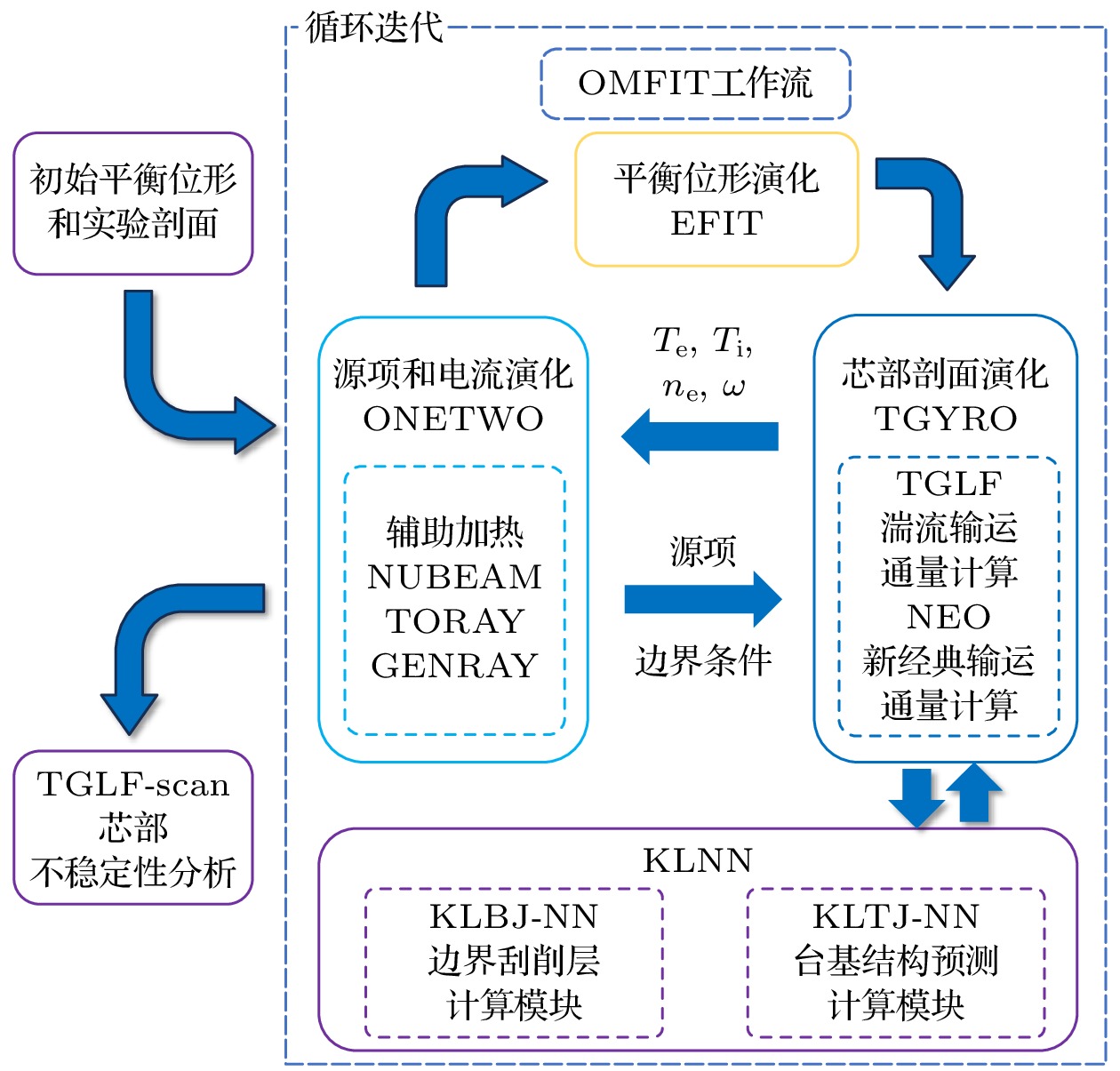
 下载:
下载:

